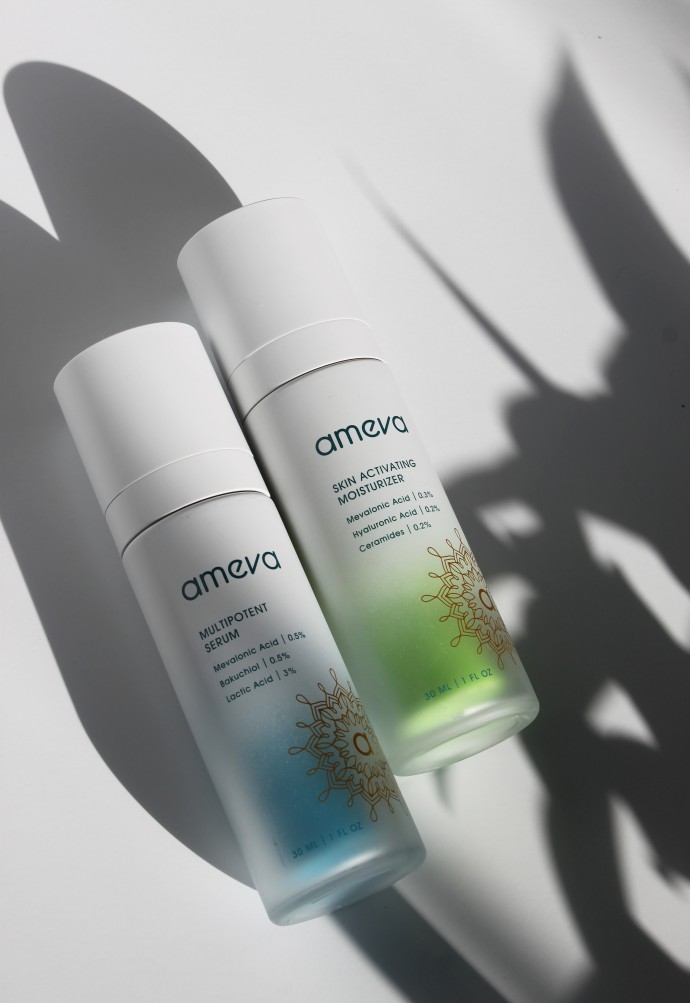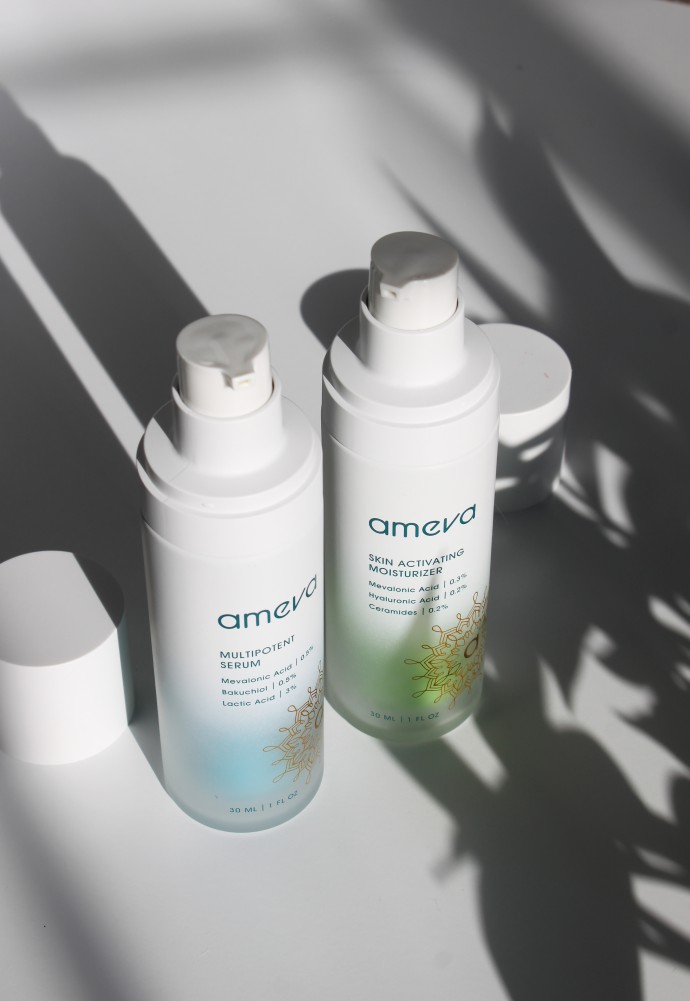Ameva Review: Is Mevalonic Acid in Skincare the Next Big Thing?
Unless you’re someone taking MCAT, you’ve probably never heard of Mevalonic Acid or mevalonate pathways. As a non-medical person, I only have a vague idea of what it is [something to do with the synthesis of essential fatty acids in cells?], but I was intrigued to hear that it can be used in skincare to replace multiple actives by helping the skin produce the necessary compounds itself. That is why I was excited to learn about AMEVA, a pioneer biotech beauty brand that launched with two products: a moisturizer and a serum. Both of them are designed to help the skin look and feel significantly better in every way: more even-toned, more resilient, brighter, smoother, more supple and elastic.
Turns out, synthesizing Mevalonic Acid is a costly and time-consuming process, which may explain why it isn’t widely used in skincare. Researchers behind AMEVA spent 10 years developing their own technology to make the production more sustainable and less expensive by using upcycled agricultural by-products that would otherwise go to waste, like sawdust and wheat straw. Currently, AMEVA is the only skincare brand that uses Mevalonic Acid as an active ingredient, produced by a sustainable, carbon-negative process.
AMEVA is committed to green and sustainable business practices. In an effort to reduce waste and carbon footprint, Skin Activating Moisturizer and Multipotent Serum both come in eco-friendly packaging that can be infinitely refilled; pods are available at amevabio.com at a significant discount. Both the serum and the moisturizer are fragrance-free, which is great for anyone with scent-sensitivities or sensitive skin in general. The ingredient lists are very short and only include the necessary compounds to support and stabilize the actives, and make the texture more cosmetically elegant.
AMEVA Skin Activating Moisturizer ($65 – $38 refill) – Daily treatment for all skin types that helps promote the look of healthy skin, deeply moisturize, and nourish the skin barrier. Active ingredients include 0.3% Mevalonolactone, 0.2% Sodium Hyaluronate, and 0.2% Ceramides.
Ingredients: Water, Helianthus Annuus (Sunflower) Seed Oil, Simmondsia Chinensis (Jojoba) Seed Oil, Glycerin, Pentylene Glycol, Glyceryl Stearate Citrate, Cetyl Palmitate, Cetearyl Alcohol, Mevalonolactone, Ceramide NP, Sodium Hyaluronate, Xanthan Gum, Maltodextrin, Swertia Chirata Extract, Tocopherol.
AMEVA Multipotent Serum ($75 – $45 refill) – A supercharged cocktail with a higher percentage of Mevalonic Acid that addresses the appearance of fine lines, redness, texture, and uneven skin tone. Active ingredients include 3% Lactic Acid, 0.5% Mevalonolactone, and 0.5 % Bakuchiol.
Ingredients: Water, Helianthus Annuus (Sunflower) Seed Oil, Pentylene Glycol, Lactic Acid, Lauroyl Lysine, Mevalonolactone, Bakuchiol, Tocopherol, Lecithin, Sodium Stearoyl Glutamate, Sclerotium Gum, Pullulan, Sodium Hydroxide, Xanthan Gum.
L to R: AMEVA Multipotent Serum, AMEVA Skin Activating Moisturizer
REVIEW:
I used both of these in the same routine for a few weeks, and finally summarized my thoughts. First of all, I really liked the serum. It had a nice smooth texture and absorbed into the skin so fast! All those active ingredients worked well to address my general skin concerns: shiny t-zone and clogged pores [Lactic Acid], occasional dehydrated patches around cheeks and nose [Mevalonic Acid], and fine lines around the eyes and mouth [Bakuchiol.] It was hard to pinpoint just how well the serum works, but I could see in the mirror that my skin just looks better from all angles – there was less overall redness and my face had a nice healthy glow.
The moisturizer was a little thicker than I expected and didn’t spread on my skin well. It sat on my face as a series of white streaks that disappeared after a couple minutes once the product absorbed. It’s a minor inconvenience, but I found it annoying having to wait before I can apply makeup, so I found myself reaching for it only at night. Patchy application aside, I think the product itself is nice enough, although I definitely prefer the serum. It was neither too light nor too heavy, and can work for people with most skin types, except the very dry skin. Sometimes I felt like my pores were too tight in areas that tend to be drier. The moisturizer seems to have a lifting effect, and I noticed that my skin looks firmer and more lifted when I use it; a welcome benefit as I’m turning 40 this year.
BOTTOM LINE:
So, is Mevalonic Acid going to become the next buzzworthy ingredient in skincare? Only time will tell, but I think it can be a good alternative for people who for some reason don’t want to use actives that can achieve similar benefits, kind of like how some people don’t want to [or can’t, due to personal sensitivities/intolerance] use retinol and choose bakuchiol instead. I think I’m going to keep the serum in my routine and pass on the moisturizer. Despite the skin benefits, I simply do not enjoy the texture and feel of the product, and that plays a major role for me when I choose my skincare.
You can purchase AMEVA skincare on their website at amevabio.com and on Amazon.
Would you try skincare with Mevalonic Acid? Have you heard of this ingredient before?




